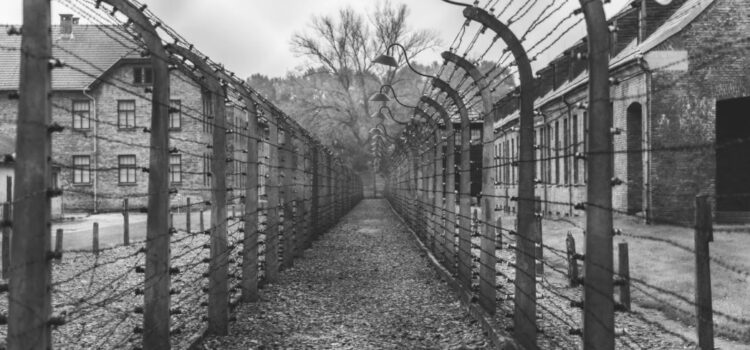

This article is an excerpt from the Shortform book guide to "The Tattooist of Auschwitz" by Heather Morris. Shortform has the world's best summaries and analyses of books you should be reading.
Like this article? Sign up for a free trial here .
How did the Gypsies in Auschwitz impact Lale’s life in The Tattooist of Auschwiz? Why did Lale become so close to the Romany people? Who was Nadya?
Lale learns a lot from the Gypsies in Auschwitz. He is fascinated by their nomadic lifestyle and spends many nights learning about their culture. However, the Gypsies were viewed as lower than the Jews during WWII and losing them reminded Lale of the horrors of the war.
Continue on to learn more about Lale’s relationship with the Gypsies in Auschwitz.
Romany in The Tattooist of Auschwitz
The story of The Tattooist of Auschwitz is based on the accounts of the real-life survivor, Lali Sokolov, as told to the author 70 years after the events. The author has stated that 95% of the story is based on Lali’s retelling and the rest imagined as creative license. However, certain historical organizations have reported that many of the events described in the novel are inaccurate or outright impossible. Therefore, this story should be viewed as a dramatized account of the characters’ lives based more on memory than factual data and not be taken as a true historical account of what life at Auschwitz was like for the thousands of prisoners held there.
This article focuses on the Romany people’s story from The Tattooist of Auschwitz. At the time, the Romany people were often referred to as “gypsies,” although that term can be seen as derogatory.
Below is the story of the Gypsies in Auschwitz from The Tattooist of Auschwitz.
Lale and the Gypsies in Auschwitz
In the spring, Lale and Leon report to work one day to find a new shipment of people like they’ve never seen before. There are the usual men and women, but now there are children and the elderly, as well. Leon cringes at the thought of tattooing children, but Lale tells him to keep his mouth shut. Baretski informs them that the people are Gypsies, lower than Jews, and that there will be a lot of them. The tattooists are relieved that the children are not to be tattooed, but their presence is still unnerving.
That afternoon, Lale returns to his room to find that his empty block is now overrun with Gypsies in Auschwitz. He always assumed his solitude would eventually be disturbed, but he never expected that his new neighbors would be families comprising several generations.
Lale doesn’t know much about Gypsies, but he worries about the safety of his stash of valuables. He decides to get to know them to assess the risk and walks into the block. He shakes hands with every one of the Gypsies in Auschwitz, spending extra time with the old women. Lale says he will do his best to relay any information he has about their safety, and they are grateful. For many of them, Lale is the first Jew they’ve ever met. That night, Lale struggles to sleep in his new world of crying babies and fussy children. But over time, he gets used to it, and the Gypsies in Auschwitz accept him as one of them.
Lale spends many nights talking with his new companions. He learns about their culture and that the word “Gypsy” is derogatory. They refer to themselves as the Romany. The children love Lale and often swarm him for treats when he comes back from work. Lale suggests that the Romany create a sort of school for the children, even just to educate them about their heritage. He often sits in on the lessons and asks questions to help further the discussion for the children. These lessons, taught by the older women, seem to give them a sense of purpose and a bit of peace.
Lale is fascinated by the nomadic life of these people, so different from his own. But there is one woman who stands out to him. She is older and, unlike the others, seems to have no family at the camp. One night, he finds her outside alone and sits next to her. They begin to talk, and he learns that her name, Nadya, means “hope.” She once had a son and husband, but both died of typhus years before. Lale tells her about his family. Something about Nadya reminds Lale of his mother, and he becomes overwhelmed with homesickness.
He thinks about his family, something he hasn’t allowed himself to do much of in the year he’s been gone. He prefers to think of them as safe at home, but now, he can’t help but wonder whether or not they are still safe. Lale reasons that there’s nothing he can do to help them, and allowing himself to fall down this rabbit hole of worry will lead to trouble. He decides that if he can’t be there for this family, he can at least be there for Nadya.
The Murder of the Gypsies in Auschwitz
One day, it’s business as usual for Lale. Thousands of Jews are brought to the camps each week, and he and Leon have their hands full with work. He still sees Gita from time to time, but even when they aren’t together, Lale is always thinking of her. There is a strange sense of stability to Lale’s life. With his work, his life with the Romany, and his relationship with Gita, he has as much of a normal routine as he can in the camp.
But his world comes crashing down one night when he wakes up to shouting and barking dogs. Lale is stunned when he sees the Romany being forced out of the block. Thousands of them are forced onto trucks, even the children and elderly, and the ones who refuse to go are shot. Lale catches sight of Nadya. He rushes to her and asks her not to go, but she says she has no choice. She must stay with her people.
The trucks drive off, and Lale slinks against the wall. Eventually, he goes back to bed, but he can’t sleep. Lale is depressed about the Romany being taken in a way he hasn’t been since arriving, not even when he thought he was going to die. They were his family, and he suffers greatly.
The next day, Lale throws himself into work to distract his mind. Mengele is up to his regular routine of picking and choosing prisoners from the line of arrivals for whatever experiments he’s conducting. As always, he makes his way over to the tattooing station and hovers over Lale and Leon. Lale does his best to ignore Mengele’s leering, but then Mengele leans down and tells Lale again that one day he will take him. Maybe that day is today.
Lale holds it together long enough for Mengele to get bored and walk away, but then an ash lands on his hand. He looks to the sky and sees it filled with ashes bursting from one of the crematorium chimneys. Lale knows whose ashes those are and cracks. He drops his tool and begins to shake. Leon tries to calm him down, not knowing what is wrong. But it doesn’t work. Lale begins to weep and curses loudly.
Lale’s breakdown draws Mengele’s attention again. He comes back over and leans close to Lale’s face. He says maybe Lale should come to his examination room to be checked out. Lale mumbles that he’s fine without looking Mengele in the face. Suddenly, Mengele pulls out his pistol and points it at Lale. He says he should shoot Lale for his insolence. He tells Lale to look at him and places the pistol to Lale’s head. Begrudgingly, Lale raises his eyes to the doctor and apologizes. The doctor sneers and moves on.
A Wake-Up Call
Lale struggles for weeks to get over his sorrow about the murder of the Romany. Gita does what she can to help him, but she doesn’t know how. He doesn’t talk and has lost the playfulness he used to have with her. She understands how he feels, but she doesn’t feel the same level of despair. She never met the Romany because Lale won’t allow her to come to his block. Further, after two and a half years of abuse and watching their people suffer incomprehensible horrors, she finds this first real display of emotion from Lale maddening.
Gita accuses him of not caring about his own people. What about the thousands of Jews killed at Auschwitz? What about the women he saw abused by Mengele? Lale realizes that because of his job, he has only seen most people as numbers, not humans. But Gita has to process the paperwork of the new arrivals. She sees their names, ages, and family details, which makes them real to her. He apologizes for his insensitivity and promises to do better.

———End of Preview———
Like what you just read? Read the rest of the world's best book summary and analysis of Heather Morris's "The Tattooist of Auschwitz" at Shortform .
Here's what you'll find in our full The Tattooist of Auschwitz summary :
- How a man used tattooing skills to stay alive at Auschwitz-Birkenau
- How Lale Sokolov fell in love in these unusual circumstances
- How Lale goes from concentration camp to Russian prisoner before finding freedom






